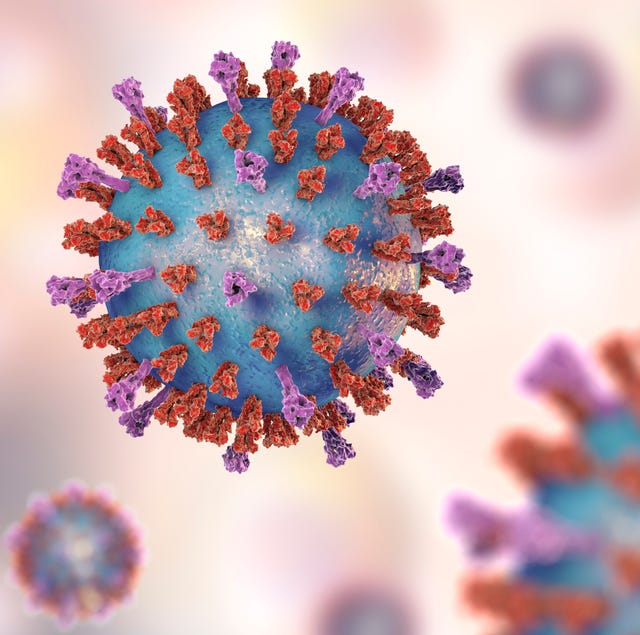
KATERYNA KON/SCIENCE PHOTO LIBRARYGetty Images
- Respiratory syncytial virus (RSV) is on the rise in the southern United States, per an advisory released by the CDC.
- The virus can cause severe illness in everyone from infants to the elderly; it is the most common cause of bronchiolitis and pneumonia in children under one year of age.
- RSV can cause symptoms similar to COVID-19.
As COVID-19 infections continue to fall across the United States, experts are now warning of another disease that could threaten everyone from infants to the elderly: RSV, or respiratory syncytial virus.
The Centers for Disease Control and Prevention (CDC) released a health advisory on June 10 about the rise of RSV, a respiratory illness that causes similar symptoms to COVID-19, in southern parts of the country.
“Due to this increased activity, CDC encourages broader testing for RSV among patients presenting with acute respiratory illness who test negative for SARS-CoV-2, the virus that causes COVID-19,” the advisory reads.
Here’s everything you need to know about respiratory syncytial virus, plus what you can to do to curb its spread.
What is RSV, exactly?
Respiratory syncytial virus is “a common respiratory virus that usually causes mild, cold-like symptoms,” the CDC explains. Although most people recover in a week or two, RSV can cause severe illness, especially in infants and older people.
Because it’s a respiratory illness, RSV spreads much the same way COVID-19 does: Respiratory droplets from infected person (often through a cough or sneeze) makes contact with your eyes, nose or mouth or you touch a surface contaminated with the virus, then touch your face.
Right now, the South is experiencing a sudden rise in RSV cases, which had been lower than normal since April 2020, the CDC notes. Lab-confirmed cases first started to rise in March 2021, and they’ve since skyrocketed in states like Florida, Georgia, North Carolina, Texas, and Oklahoma.
What symptoms does RSV cause?
RSV causes a few typical symptoms that are similar, but not identical, to those caused by COVID-19, per the CDC. These are the most common, which usually appear in stages—not all at once:
- Runny nose
- Decrease in appetite
- Coughing
- Sneezing
- Fever
- Wheezing
Most RSV infections clear up after two weeks. Patients who have trouble breathing or who are dehydrated should be hospitalized; in severe cases, a person might have to be put on oxygen or intubated, according to the CDC.
Almost all children will have had an RSV infection by age 2, the CDC notes. Annually, 58,000 kids younger than five and 177,000 adults 65 or older are hospitalized with RSV; 100-500 of those children and 14,000 of those adults die of the disease.
How is RSV treated?
“There is no specific treatment for RSV infection,” the CDC notes. Instead, patients can focus on easing their symptoms by taking over-the-counter fever reducers and pain relievers and drinking plenty of fluids. Parents should contact their child’s pediatrician before administering nonprescription cold medicines, the CDC warns, because certain ingredients might be harmful to kids.
You can prevent the spread of RSV by following the same precautions as you would with COVID-19, the CDC says, including washing your hands thoroughly and frequently, avoiding close contact with infected people, and wearing a mask or covering your sneezes and coughs if you’re sick.
If you suspect you have RSV (or have any cold-like symptoms), keep up with those practices and try to avoid close contact with children at high risk of severe illness, the CDC recommends. When in doubt, get tested.
This content is created and maintained by a third party, and imported onto this page to help users provide their email addresses. You may be able to find more information about this and similar content at piano.io
Health - Latest - Google News
June 16, 2021 at 02:10AM
https://ift.tt/2StyPTH
What Is RSV? CDC Warns of Respiratory Syncytial Virus Rising in the Southern U.S. - Prevention.com
Health - Latest - Google News
https://ift.tt/2zrj9Ud
Bagikan Berita Ini















0 Response to "What Is RSV? CDC Warns of Respiratory Syncytial Virus Rising in the Southern U.S. - Prevention.com"
Post a Comment